
Thalys is a French-Belgian high-speed train operator originally built around the LGV Nord high-speed line between Paris and Brussels. This track is shared with Eurostar trains that go from Paris, Brussels or Amsterdam to London via Lille and the Channel Tunnel and with French domestic TGV trains. Thalys also serves Amsterdam and Cologne.
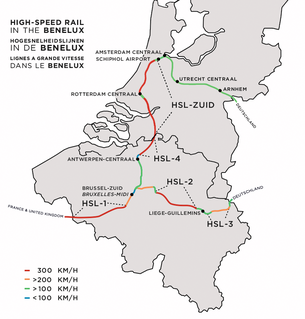
The HSL-Zuid, is a 125 kilometre-long Dutch high-speed railway line running between the Amsterdam metropolitan area and the Belgian border, with a branch to Breda, North Brabant. Together with the Belgian HSL 4 it forms the Schiphol–Antwerp high-speed railway. Originally scheduled to be in service by 2007, the first public operations began on 7 September 2009, after a ceremony on 6 September.

Amsterdam Zuid is a railway station situated in the borough of Amsterdam-Zuid in Amsterdam, Netherlands. For a number of years, it was named Amsterdam Zuid WTC, in reference to the neighbouring World Trade Center Amsterdam. During 2006, in conjunction with the rapid development of the area surrounding the station, the station was enlarged and the reference to the WTC was formally dropped from the name.

The Cologne-Frankfurt high-speed railway is a 180-kilometre-long (110 mi) railway line in Germany, connecting the cities of Cologne and Frankfurt. Its route follows the Bundesautobahn 3 for the greater part, and currently the travel time is about 62 minutes. The line's grades of up to four percent require trains with a high power-to-weight ratio which is currently only met by third-generation Intercity-Express trains. It was constructed between 1995 and 2002 at a total cost of six billion Euro according to Deutsche Bahn.

The HSL 2 is a Belgian high-speed rail line between Leuven and Ans and is 66.2 km (41 mi) long, all of it on dedicated high-speed tracks, which began service on 15 December 2002. As part of the Belgian railway network, it is owned, technically operated and maintained by Infrabel.
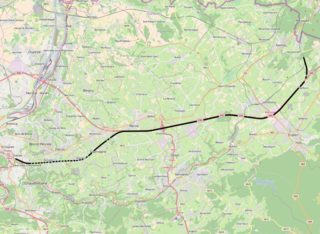
The HSL 3 is a Belgian high-speed rail line. It connects Liège to the German border near Aachen. The high-speed track length is 42 km (26 mi).

The HSL 4 is a Belgian high-speed rail line part of the 87 kilometres axis which connects Brussels to the Dutch border. It is 40 kilometres long ; 36 kilometres of it being dedicated high speed tracks. It was scheduled for completion by 2005 and opened in 2009.

The Lelystad–Zwolle railway, also known as the Hanzelijn, is a Dutch railway line, finished in 2012. It connects Lelystad, capital of the province of Flevoland, with Zwolle, capital of the neighbouring province of Overijssel, and provides a direct rail link between Flevoland and the north-east of the Netherlands.

The Turkish State Railways (TCDD) started building high-speed rail lines in 2003. TCDD has branded its high-speed service as Yüksek Hızlı Tren (YHT) which currently operates on two lines: the Ankara–Istanbul high-speed railway and the Ankara–Konya high-speed railway. YHT is the only high-speed rail service in Turkey, with two types of EMU train models operating at speeds of up to 250 km/h (HT65000) or 300 km/h (HT80000).
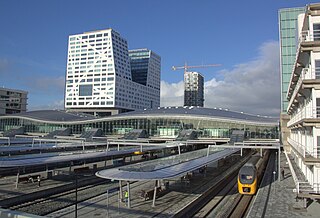
Utrecht Centraal, officially Station Utrecht Centraal, is the transit hub that integrates two bicycle parkings, two bus stations, two tram stops and the central railway station for the city of Utrecht in the province of Utrecht, Netherlands.
This article lists planned or proposed high-speed rail projects, arranged by country. Although many nations have done preliminary feasibility studies, many lines are eventually shelved or postponed due to high cost, and only a few nations of those proposing are actively building high-speed rail lines. Planned or proposed lines are therefore separated here from lines that are under construction, some nations having both. High-speed rail is public transport by rail at speeds in excess of 200 km/h (125 mph).

Belgium's high-speed rail network provides mostly international connections from Brussels to France, Germany and The Netherlands. The high-speed network began with the opening of the HSL 1 to France in 1997, and since then high-speed lines have been extended towards Germany with HSL 2 in 2002, HSL 3 from Liège to the German border in 2009, and HSL 4 from Antwerp to the Dutch border in 2009.

In February 2009, the government of Portugal announced plans to build a high-speed rail line from Lisbon to Madrid; this plan was cancelled in March 2012 amidst a bailout programme of financial assistance to the Portuguese Republic. The project was valued at €7.8 billion and the government had claimed it would create 100,000 jobs. The line would link to Spain's Southwest Corridor.

Rail transport in the Netherlands uses a dense railway network which connects nearly all major towns and cities. There are as many train stations as there are municipalities in the Netherlands. The network totals 3,223 route km on 6,830 kilometres of track; a line may run both ways, or two lines may run on major routes. Three-quarters of the lines have been electrified.

Although Finland has no dedicated high-speed rail lines, sections of its rail network are capable of running speeds of 200 km/h (120 mph). The Finnish national railway company VR operates tilting Alstom Pendolino trains. The trains reach their maximum speed of 220 km/h in regular operation on a 75.7 km (47.0 mi) route between Kerava and Lahti. This portion of track was opened in 2006. The trains can run at 200 km/h (120 mph) on a longer route between Helsinki and Seinäjoki and peak at that speed between Helsinki and Turku. The main railway line between Helsinki and Oulu has been upgraded between Seinäjoki and Oulu to allow for trains to run at speeds between 160 km/h (99 mph) and 200 km/h (120 mph). Other parts of the Finnish railway network are limited to lower speed.
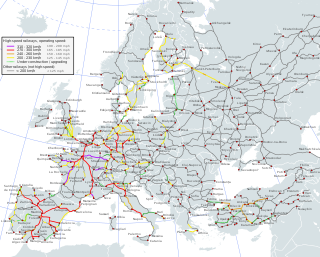
High-speed rail (HSR) has developed in Europe as an increasingly popular and efficient means of transport. The first high-speed rail lines on the continent, built in the 1980s and 1990s, improved travel times on intra-national corridors. Since then, several countries have built extensive high-speed networks, and there are now several cross-border high-speed rail links. Railway operators frequently run international services, and tracks are continuously being built and upgraded to international standards on the emerging European high-speed rail network.

The Transitalia ETR 700, previously NS Hispeed V250, is a high-speed train designed by Pininfarina and built by AnsaldoBreda initially to operate on the Fyra-service, a high speed train of NS International and NMBS/SNCB between Amsterdam and Brussels with a branch to Breda on the newly built HSL-Zuid in the Netherlands and its extension HSL 4 in Belgium.
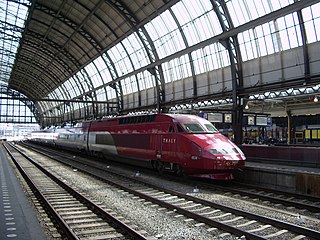
High-speed rail service in the Netherlands started at 13 December 2009 with the dedicated HSL-Zuid line that connects the Randstad via Brussels to the European high-speed rail network. In later years improved traditional rail sections were added to the high-speed network. Proposals for more dedicated high-speed lines were deemed too costly; plans for the HSL-Oost to Germany were mothballed and instead of the Zuiderzeelijn the less ambitious Hanzelijn was built to enable future high-speed service between the northern provinces and the Randstad.

High-speed rail service commenced in Poland on 14 December 2014, with the introduction of 20 non-tilting Pendolino trainsets operating on 4 designated lines radiating out from Warsaw. Polish State Railways started passenger service trains PKP Pendolino operating a speed 200 km/h on 80 km line Olszamowice-Zawiercie. From December 2017 there are two 200 km/h sections, 136 km long in total. Polish state railways PKP launched the high-speed service under the Express Intercity Premium (EIP) brand name.

The Oberhausen–Arnhem railway is a two-track, electrified main line railway running close to the lower Rhine from Oberhausen via Wesel, Emmerich and the German–Dutch border to Arnhem and forms part of the line between the Ruhr and Amsterdam. The line was opened by the Cologne-Minden Railway Company in 1856 and is one of the oldest lines in Germany.

















